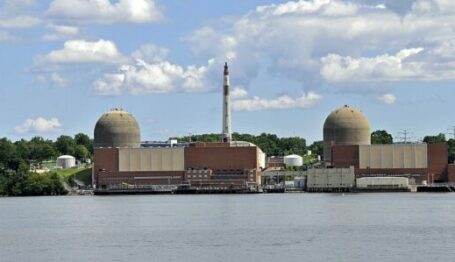Green Watch
Wind Power Doesn’t Make Sense: Berkshire Hathaway


Wind Power Doesn’t Make Sense Without the Tax Credits (full series)
Berkshire Hathaway | “An Extremely Rare Occurrence”
Anti-Environment Environmentalism
Myths are an ever-present ingredient in promises made by the wind and solar energy industry. The magic can turn to farce when gullible media tries to make sense of it.
“NV Energy Assures No Loss of Solar Power During Eclipse,” promised the online headline attached to an October 2023 TV newscast from KTVN-2 in Reno, Nevada.
The station motto is “Coverage you can count on,” but don’t count on them getting an “A” in astronomy. As the video revealed, NVEnergy wasn’t really planning to move the moon out of the way. Instead, they used backup battery storage and natural gas power plants to make up for the missing sunlight.
NVEnergy’s parent firm is Berkshire Hathway Energy (BHE). A lot of BHE’s subsidized weather-dependent energy business makes as much sense as promising solar power without sunlight.
Berkshire Hathaway
Warren Buffett is the CEO of Berkshire Hathaway, the investment conglomerate that controls BHE. As of December 2023, according to Bloomberg, Warren was worth $121 billion. But investing in firms that provide better stuff and services isn’t the only reason Berkshire built Buffett that big bank account.
“I will do anything that is basically covered by the law to reduce Berkshire’s tax rate,” said Buffett in 2014. “For example, on wind energy, we get a tax credit if we build a lot of wind farms. That’s the only reason to build them. They don’t make sense without the tax credit.”
Shortly afterwards, he got really good at this.
“Warren Buffett’s energy division has reported a negative income tax rate for five straight years, thanks to billions of dollars’ worth of tax credits it’s received for producing clean power,” reported Yahoo Finance in September 2023.
For 2019 through 2022, the analysis showed Berkshire Hathaway Energy had severely turned the tables on the IRS, harvesting $6.1 billion in tax payments from the federal government. And for the first quarter of 2023 things got really silly when BHE reported a negative 163 percent tax rate, meaning the firm literally collected more harvesting tax payments from federal taxpayers ($363 million) than it made in profits for providing electricity ($223 million).
But as Buffett implied in 2014, don’t hate the player, hate the game.
A crooked federal tax policy that grossly subsidizes weather-dependent power systems is the reason we’re all paying taxes to the energy firm controlled by one of the planet’s richest people. And it’s getting worse, due to nearly $400 billion in additional climate policy corporate welfare larded into the so-called Inflation Reduction Act.
“They Don’t Make Sense Without the Tax Credit”
MidAmerican Energy, another Berkshire Hathaway Energy subsidiary, operated 22 of the 121 Iowa wind facilities listed in the U.S. Department of Energy database for 2022. The MidAmerican share of the total covered approximately 1,500 square miles of the state.
The land and skies of Iowa are apparently littered with weather-dependent wind turbines.
To get a handle on how big MidAmerican’s 1,500 square mile share is, imagine the vastness of Great Smoky Mountain National Park . . . plus Zion National Park . . . plus Rocky Mountain National Park. It’s even a tiny bit bigger than all of that.
On that huge hunk of Iowa, but only when the wind was cooperating, MidAmerican generated a combined 28 terawatt hours (TWh) of electricity in 2022.
For comparison, the Palo Verde nuclear energy facility in Arizona generated 31.9 TWh of power in 2022. Palo Verde did the job pretty much whenever the power was needed, rather than when the weather cooperated. American civilian nuclear reactors are extremely reliable.
Palo Verde produced almost 14 percent more carbon-emissions-free electricity than did all of MidAmerica’s Iowa wind turbines. And it did it from just a 6.4 square mile patch of Earth conveniently located 55 miles north of downtown Phoenix, where millions of customers could use it.
If the goal were to crank out electricity without carbon emissions, rather than harvest tax subsidies, it could be accomplished far more efficiently by filling up far less of Iowa.
In 2019, Iowa’s Duane Arnold Energy Center provided more than 5.2 TWh of nuclear power. The facility was shut down the following year. The Palisades nuclear plant on the southeast shore of Lake Michigan was shuttered in 2022, but kicked out 7 TWh of electricity in 2021. And in 2019, the last year both reactors were still operating at full strength, New York’s Indian Point 2 and Indian Point 3 combined to deliver almost 17.5 TWh of nuclear energy.
Add them together and these four recently mothballed nuclear plants, sited on combined real estate of just 1.8 square miles, provided more annual carbon-free energy than all 1,500 square miles of MidAmerican’s Iowa wind turbine fields.
Using data for 2022, energy journalist Robert Bryce recently reported that federal wind-energy subsidies were a scale-smashing 69 times heavier per unit of electricity created than nuclear energy subsidies.
Wind turbines aren’t scattered across Iowa because it makes sense, but because it makes subsidies. According to a 2018 report in the Des Moines Register, MidAmerican Energy had by that point invested $12.3 billion to build 2,200 wind turbines in the state, but received back $10 billion in federal wind production tax credits. “We get a tax credit if we build a lot of wind farms. That’s the only reason to build them. They don’t make sense without the tax credit.”
Buffett didn’t grow rich by being an idiot.
In the next installment, wind energies offer comically redundant excuses for wind turbine failures.



